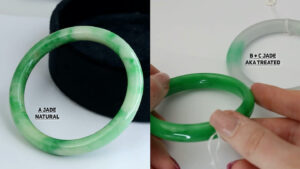By Kristina Mason, Mason-Kay Jade
Gemstones like Jade can be intimidating simply due to a lack of understanding. Pearls are another category that can suffer a similar fate, except that recently, more efforts have been made to educate and demystify the cultured Pearl trade. Mason-Kay Jade, a company established in 1976, feels it is their duty to do the same for Jade.
Natural jadeite Jade can be appreciated—and sold in stores—for its incredible history and legacy simply by dispelling myths and understanding Jade basics. Known as “The Inscrutable Gem,” Jade’s story is surrounded by mystery and misunderstanding. Jadeite Jade was carved and revered by at least seven different Mesoamerican civilizations over the course of thousands of years in the form of currency, religious artifacts, tools, weaponry, and more. Introduced to China in the late 1700s, jadeite Jade captured the attention of the Qianlong Emperor and later the Dowager Empress Cixi. Nephrite Jade’s history, meanwhile, dates back 8,000 years as China’s Stone of Heaven.
There’s a lot of history behind and beauty to love about Jade! Commit these four fundamentals about Jade to memory and watch appreciation and sales follow.
1. Nephrite or Jadeite? Which one is Jade?
BOTH! Jade is a trade term that is gemologically assigned to two different gemstones: Nephrite and Jadeite. Nephrite Jade is the Jade of ancient China, known as the toughest gemstone in the world. Jadeite Jade is harder (more resistant to scratching) than nephrite Jade and is considered the second toughest gemstone in the world. Nephrite Jade is more abundant and isn’t commonly seen in the wide range of hues that jadeite Jade is known for. They are both beautiful gems with a breathtaking luster and are incredibly connected to history and nobility.

2. Natural vs. Treated Jade (Jadeite)
While nephrite Jade can be treated, it’s not common nor is the matter of disclosure as pressing as in the case of jadeite Jade. Natural jadeite Jade is sometimes called A Jade and refers to untreated jadeite that may, at the most, have a coating of beeswax on the surface. In the case of Jade, as compliant with AGTA treatment codes, “natural” means “not enhanced” or untreated.
Treated jadeite is not as tough, stable, or valuable as natural Jade. In the case of durability, B Jade (with polymer), C Jade (dyed), and B+C Jade (polymer and dyed) are significantly more brittle on account of being acid-bleached and impregnated with polymers or dyes.
In the case of stability, B and C Jade and B+C Jade can potentially change color if the dye fades or if the polymers or acids release from the stone.
In the case of value, B Jade is only worth approximately 5–10% the value of its natural Jade look-alike. And due to the presence of dye, C Jade and B+C Jade have little to no value at all.
Click here to learn more about the different grades of Jade.

3. Jade Isn’t Just Green!
Jadeite Jade can be found in a vivid array of colors including green, lavender, ice (colorless and translucent like moonstone), red, orange, yellow, white, gray, and black.
Nephrite Jade also comes in many different colors, its most valuable color called mutton fat Jade, a creamy, pure white color that some Jade connoisseurs may spend a lifetime chasing.
Click here to learn more about the different colors of Jade.

4. Jade Is Ideal for Everyday Wear
Jadeite Jade is the harder of the two Jades, with a hardness of 6.5–7. It’s often cut as a cabochon, and customers who have been properly instructed on Jade care can go decades without needing their stone repolished—and if particularly well cared for, some never do!
When explaining it to your staff, tell them that jadeite Jade is comparable to Garnet in hardness, and it’s closer in hardness to Sapphire than Sapphire is to Diamond.

Regarding toughness, or resistance to breaking, you can’t go wrong with either of the Jades! Considered the two toughest gemstones in the world, Jade’s legacy in China is directly connected to its strength and durability. Jadeite Jade varies in toughness depending on its internal microstructure, but by some metrics it’s considered to be up to 24 times harder to break than Diamond!
Check out these video links to learn more about Jade.
